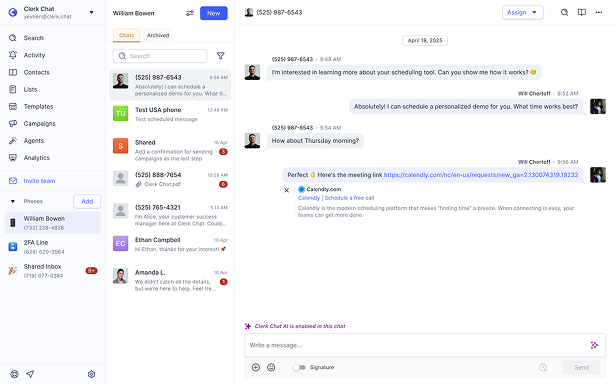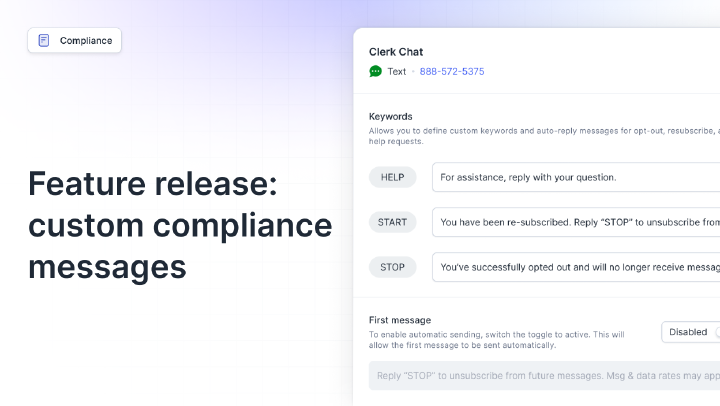Conversational Messaging: Turning Conversations into Conversions
By Alexander Haque
- Updated: August 14, 2025
Most people hate talking to companies. They don’t want to be on hold. They don’t want to dig through a website just to find a contact form. They don’t want to explain the same issue three times to three different people. But they do want help, or guidance.
They want to ask a question and get an answer quickly, without having to switch to another channel, or wait around. That’s what conversational messaging delivers.
It’s not a shiny new communication channel – it’s just how people already connect, with friends, family, and colleagues. In fact, around the world, more than 23 billion messages are sent daily by text alone. Messaging is casual, immediate, and it fits into people’s lives naturally.
Your customers want you to adapt to that fact – 89% say that they’d prefer to communicate via text than make a call to a business.
So why are most companies still stuck on hold music and email tickets?
That’s the gap. This guide is here to close it.
In this article:
What is Conversational Messaging?
Conversational messaging is a form of real-time two-way conversation that often takes place between businesses and their target audience. Crucially, it’s not just another term for two-way text messaging (although conversations can take place over SMS/MMS).
Conversational messages can be sent via any of your customer’s preferred messaging channels, from WhatsApp, to Viber, Facebook Messenger, and beyond. The main difference between conversational messaging, and the standard messaging strategies companies use is that you have a dialogue – not a monologue. You’re not just blasting out updates or promotions. You’re listening, and responding.
For instance, you use RCS business messaging to send customers a notification about a product launch. They reply, “Do you have that in green?” and your team (or an AI bot) answers.
That back-and-forth builds trust, and trust builds loyalty.
Let’s turn chats into customers
Transactional vs Conversational Messaging
Messaging isn’t exactly a new communication channel for most companies. The rising proliferation of smartphones worldwide, and the popularity of apps like WhatsApp have prompted countless businesses to embrace messaging strategies.
However, many of the messages sent to customers by businesses today are still “one-way”. We’re all familiar with the A2P messaging methods companies use to enable things like multi-factor authentication. Plus, plenty of companies use automated text messaging to inform customers about upcoming sales, and promotions, or keep them up to date on their order’s location.
Here’s the difference in one sentence: Transactional messaging tells. Conversational messaging asks and answers. A transactional message sent by a company using finance SMS might say “your appointment is booked for 10am.” A conversational message says, “Do you need to reschedule, or get directions to the office?”
You still need transactional notifications to keep customers informed. Conversational messaging just ensures there’s still an opportunity for two-way communication in situations when customers need more guidance or a real-time response via SMS, WhatsApp, or any other channel.
Conversational Messaging Channels
The number one conversational messaging channel for most companies is still SMS or MMS. Standard text messages still have the best reach of any messaging solution. But today’s companies aren’t limited to just text.
The latest conversational messaging platforms make it easy to align a range of different channels from Facebook Messenger and WhatsApp, to Rich Communication Services (RCS), Google’s business messages, and even in-app messages.
A conversational messaging platform enables an omnichannel approach to customer service, without putting extra work on the shoulders of your customer experience representatives or sales staff.
Most empower companies with a unified inbox, so your team can manage every discussion in space, without jumping between apps. They also frequently come with conversational AI built-in, so you can automate common discussions with intelligent assistants.
The Benefits of Conversational Messaging
So, why bother with this two-way messaging strategy? Simply put, customers love using messaging to communicate with brands. Studies show that 83% of customers say they feel more confident in brands that offer messaging as an option for communication.
People are using smartphones and messaging apps on a daily basis, and they expect companies to “meet them” where they are. However, while more than 3 billion people use messaging apps every day, many companies still only manage two-way conversations via email and phone.
Embracing a conversational messaging strategy, whether it’s for customer service text messaging, or marketing, is a great way to differentiate yourself from the competition.
But that’s not all, conversational messaging delivers other benefits too:
Improved Reach and Visibility
Let’s start with the basics: visibility. The average email open rate? Around 20%, if you’re lucky. SMS? 95%, usually within a few minutes. WhatsApp and Messenger? Even better, depending on the context. People check their messages. They read them. They reply.
Whether you’re trying to gather customer feedback, upgrade support, or just keep people informed with scheduled text messaging, you end up with better reach. Plus, with two-way communication empowering customers to actually ask questions and get real-time responses, you get a new way to build trust, and loyalty.
More Chances to Convert
A single message can start a conversation. A conversation can turn into a sale.
That doesn’t happen with one-way notifications. It happens when there’s room for questions. Curiosity. Clarification. Imagine this: someone clicks through a product link. They want to know if it’s in stock. They reply to the promo message. You respond with a personalized message, and they confirm the purchase.
AI can help too. The top conversational AI platforms give you agents that can streamline lead qualification, ask relevant questions, or make suggestions based on customer preferences. Some can even help you develop a personalized messaging strategy for each lead.
Increased Customer Trust and Loyalty
Most companies think loyalty comes from discounts. But often, it comes from how easy you are to talk to. 89% of customers say they want to engage in two-way conversations via messaging apps. If you can deliver what your customers are asking for, you’ll be more likely to build powerful, long-term relationships.
Conversational messaging makes customers feel heard. No one wants to fight to get help. Or explain their issue to five different agents. Or wonder if their message got lost in some generic “support@” inbox. They just want an easy way to connect and get answers.
With AI tools for customer support, you can even make sure customers always get a response whenever they reach out – even if it’s not during standard business hours. The result is higher customer satisfaction rates, and loyalty that stays strong, year after year.
You Spend Less to Support More
Support is expensive. Hiring, training, scheduling – it all adds up. Even with a solid team, the volume can quickly become overwhelming. This is where automation actually helps.
Not “we’ll get back to you in 24 hours” auto-replies. Real-time answers, powered by AI assistants that know how to route issues, answer FAQs, and hand things off when needed.
You’re not replacing humans; you’re using conversational AI in customer service to handle repetitive tasks, and let your human employees focus on what they do best: handling nuance, building rapport, and solving the weird edge cases that bots can’t.
Your customer service costs go down, along with the costs involved in managing your multichannel approach to support, but customer satisfaction scores go up.
Stronger Insights into People Actually Want
Every message is a data point.
What people ask. What they click. What they ignore. What they’re confused about. What keeps coming up again and again.
Conversational messaging opens a feedback loop. Over time, you’ll see patterns. Friction points. Opportunities to improve pulled from genuine customer feedback, and data. With AI in customer service, even identifying common patterns becomes a lot faster and easier.
You can analyze countless conversations quickly, learning more ab out customer preferences, potential issues, and what really works for sales and marketing teams. That can guide everything from your lead qualification strategy, to your plan for building future products.
Use Cases for Conversational Messaging
If all you’re using messaging for is support, you’re only scratching the surface. Conversational messaging is great for customer service, particularly when it’s paired with AI tools that can manage after-hours replies, and queries across communication channels.
But there are other use cases worth exploring too.
Conversational messaging can plug into almost every part of your business. Sales, marketing, service, operations: whatever you need to do, there’s probably a faster, clearer, more helpful way to do it via chat.
Marketing That Starts a Conversation
Traditional marketing is loud. A message gets blasted to a list and that’s it.
No reply option. No room for questions. No chance to clarify or redirect.
Now imagine the same promo, but it comes with a “Reply if you want a sample” or “Want help picking a style?” CTA. For instance, a company using messaging and conversational AI for hospitality could send a notification about an upcoming deal, then when a customer responds, a chatbot could walk them through planning their itinerary.
These conversations often start with A2P channels like SMS or WhatsApp Business API, but when handled properly, they become part of a real back-and-forth. Customers ask about the product. You guide them to what they need.
Sales That Don’t Feel Like Selling
Here’s where things get interesting.
If someone messages you asking about sizing, or color, or compatibility, they’re probably close to buying something. All you need to do is give them clarity, so they can make the right choice.
Messaging lets you become the helpful rep without the pressure of a storefront. When a customer responds to your interactive marketing campaigns with a query, you can respond instantly. That might mean having a human team member handle the case, or using conversational AI in financial services, retail, or hospitality to move things along.
Some solutions can even help empower your sales team, capturing nurture information to help your team members identify valuable leads, and send them personalized product recommendations.
Customer Support Without the Wait
You already know the drill: the more accessible you are, the happier your customers. Conversational messaging takes that further. Not just access, but resolution. You’re not just sending appointment reminders, delivery updates, or notifications. You’re giving customers a quick and easy way to discuss their needs in a channel they feel confident with.
It’s faster than a phone call, more personal than email, and more flexible than live chat, especially when you add chatbots, after-hours replies, or automation that routes issues based on the message itself. AI tools can catch the easy stuff:
- “Where’s my order?”
- “How do I update my address?”
- “What’s your return policy?”
Then they can hand the other issues – the ones that actually need human support, over to an employee, along with context, and data on customer preferences.
Operations and Internal Coordination
Messaging isn’t just for customers. It works inside the business too.
- A support agent flags an issue and loops in fulfillment.
- The sales team hands off a qualified lead to onboarding.
- A shift supervisor reports a delivery delay and it auto-updates customer ETAs.
All inside the same conversational messaging platform, one that combines your messaging apps, group texting service, and AI tools. When information moves like this, quickly and transparently, things don’t fall through the cracks.
Reminders, Updates, and Time-Savers
Not every message has to sell something. Some just need to get seen.
- Appointment reminders.
- Delivery updates.
- Check-ins.
- “We haven’t seen you in a while…” nudges.
The difference is: when you make these two-way, people can actually respond.
- “Can I reschedule?”
- “Actually, I’m not home, leave it at the side gate.”
- “Not interested anymore. Please unsubscribe.”
These aren’t dead ends, they’re part of the experience, and when you make room for that, people feel respected and more in control.
Let’s turn chats into customers
How to Create a Winning Conversational Messaging Strategy
So, how do you develop a strong conversational messaging strategy? Fortunately, it’s not as complicated as it seems. While the steps you take will vary depending on things like your industry, and your goals, here’s the step-by-step guide to getting started.
Step 1: Pick the Channels That Make Sense
As mentioned above, there’s more to two-way messaging than just conversational SMS. However, it’s definitely worth embracing SMS to start with. Remember, 95% of people read SMS messages within three minutes, and about 70% of the world’s population uses SMS and MMS messaging regularly.
Business conversations are happening across leading messaging platforms today. Learn your customers’ channel preferences and meet them there. For instance, some customers prefer WhatsApp, where they can look up your business and instantly start a conversation.
Many clients use iMessage daily. So, why not also use it for your company’s conversation marketing? RCS solutions are excellent for marketing campaigns and commerce alerts, because they can include lots of rich media like videos and GIFS and SMS is a versatile communication method.
You don’t need to be active on every channel – just the ones that align with your customer preferences.
Step 2: Decide How to Use Conversational Messaging
Once you’ve chosen your channels, the next step is figuring out what kind of two-way conversations you’re going to be having. The most common way to use conversational messages is for customer support.
Instead of just sending customers updates about their orders with transactional SMS, you can use conversational messaging to engage in personalized conversations with customers. Even if you use AI tools for this two-way conversation, it can lead to a much better customer experience.
On top of customer service, you might use conversational messages for:
- Marketing purposes: E.g. Send a marketing message to a customer promoting a recent product collection, and ask them to respond for more information on a specific item.
- Engagement: E.g. Sending messages to customers asking them for feedback on your products or services, or asking them to share ideas for your next product.
- Service delivery: E.g. A bank could use finance SMS messages to deliver product suggestions to customers, or discuss account features with them.
- Sales: E.g. Retailers can use two-way messaging for conversational commerce, allowing people to purchase products or book services via chat.
You can implement messaging for internal team connections too, using group messaging and integrations with conversational AI for logistics or supply chain teams to keep everyone informed.
Step 3: Choose the Right Conversational Messaging Platform
Now you have your use cases for conversational messaging, you need the right platform. The best conversational messaging platform won’t just enable two-way conversations. It will give you the tools you need to personalize customer experiences, preserve security, and scale your strategies.
Look for a solution from a provider that knows the difference between conversational AI vs chatbot systems. Make sure the platform supports all of the communication channels you’ve chosen to embrace.
For instance, a solution like Clerk Chat makes it easy to develop conversational messaging strategies, with templates and snippets you can personalize to suit each customer, built-in security features, and advanced AI technology. With Clerk Chat you can:
- Access AI: Leverage the AI Clerk Assistant to send auto response text messages to customers, keeping the conversation going even when human agents aren’t available.
- Integrate multiple channels: Connect your two-way messaging strategy to your CRM to enable personalization, or link integrations to other messaging channels like WhatsApp.
- Preserve compliance: Maintain compliance with 10DLC standards, collect opt-in details, and protect yourself from reputational damage.
- Analyze results: Leverage analytics and reports to track the results of your marketing, sales, and customer support strategies.
- Scale your strategy: Build on your messaging strategy with additional workflows for transactional SMS, promotional SMS, and more.
Most importantly, pick something your team can actually use, not something that looks good in a demo and gathers dust after onboarding.
Step 4: Make the Experience Actually Enjoyable
Studies show that 70% of people feel more connected to companies they can message. However, you can still damage your relationship with customers by taking the wrong approach. Your focus with two-way messaging should be on improving customer relationships.
Boost the customer experience by:
- Personalizing interactions: Link your conversational messaging apps to your CRM system so you can preserve context from one channel to the next, track crucial data, and deliver a relevant, personalized experience to each customer.
- Making the experience accessible: Use multiple messaging channels where possible to give your customers more options on how to connect with you. Remember, not every customer will necessarily have a WhatsApp (or similar) messaging account.
- Keeping it simple: Make it easy for customers to interact with you. For instance, if you’re using automated tools to enable conversational banking, give your customers a clear list of options when they start interacting with you, to help direct them to the right representative.
Step 5: Leverage AI and Automation
AI SMS and messaging solutions can help you gather more information about your customers, which can help you to personalize future conversations and make intelligent decisions about how to improve the customer journey.
Conversational AI tools, like Clerk Chat’s trainable AI Assistant, can also automate some of the discussions you have with your audience, allowing you to offer 24/7 service and support, or proactively reach out to customers to collect data, and deliver personalized product recommendations.
Consider using an AI-powered platform to leverage features like:
- Instant or delayed responses
- AI-powered customer service
- On-brand, peresonalized interactions
- 24/7 sales operations, following up on leads
You’re not removing people from the loop. You’re reserving their time for the stuff only people can do.
Step 6: Remember Messaging Etiquette Matters
Messaging is intimate. It shows up next to people’s texts from friends, partners, and kids. If you abuse that space, they’ll block you, and they’ll remember.
So follow some basic ground rules:
- Get permission. Opt-ins only.
- Make it easy to opt out of communication without friction.
- Keep the tone aligned with the channel (casual on Messenger, straightforward on SMS)
- Don’t message just to message
- Respond when people write back. Quickly.
If your scheduled text messaging feels like spam, it probably is. If your tone feels weird or cold, people will ghost you. When your messages feel like they were written by an intern with a thesaurus, take another pass.


The Future of Conversational Messaging
Most people don’t want more apps. They want fewer tabs open. One conversation that doesn’t disappear. One place where they can ask, check, change, or cancel, and get a straight answer. That’s where conversational messaging is headed.
From Channels to Conversations
Right now, most companies treat messaging like an add-on. Something layered on top of existing support. Or an experiment from the marketing team.
But for customers, it’s becoming the main thing. The default.
It’s not about SMS vs. WhatsApp. Or live chat vs. RCS. The question is simpler than that:
“Can I just message you?”
If the answer is yes, and the experience is good, you’ve got a customer who’s likely to stick around. If the answer is no? They’ll move on.
Messaging Is Becoming the Interface
Websites are still useful. Apps still matter. But they’re not always the first stop anymore.
- Someone finds your business on Google. They click “Chat.”
- They have a question about returns. They message.
- They check delivery ETA. They reply to a previous thread.
No menus. No downloads. Just a message. That’s the interface now. What used to take a web form and a three-day wait happens in one thread. Sometimes in one minute. That’s what sets the tone for your entire brand experience.
RCS Is Quietly Changing Expectations
You won’t always hear about it on the news, but RCS messaging is picking up steam.
It looks like SMS, but it isn’t. It supports images, buttons, location links. It’s clickable. Swipeable. Easier to act on.
Early data shows RCS driving higher click-through rates. More engagement. Less drop-off. Especially when used for product announcements or delivery updates.
If you haven’t started experimenting with RCS yet, now’s the time to start, particularly since Apple is beginning to support the protocol too.
AI Is Getting Better at Knowing When to Step Aside
Not all automation is helpful. We’ve all argued with a bad chatbot.
But agentic AI, the kind that follows logic and understands context, is improving fast. It can route messages. Trigger updates. Know when to pass things off to a real person.
The goal isn’t to fake human support. The goal is to avoid wasting anyone’s time.
Used right, AI helps. Used wrong, it just adds noise. Smart companies are already finding the line.
Get Started with Clerk Chat’s Conversational Messaging Tools
Conversational messaging is a powerful tool for today’s businesses. It can help you boost customer engagement, accelerate growth, and even unlock additional revenue. However, achieving the right results means investing in the right technology, and strategy.
With Clerk Chat, companies can easily build a conversational messaging strategy that leverages all of the channels their customers want to use for communication.
Clerk Chat supports integrations with a range of messaging apps, as well as your CRM system, paving the way for flexible, personalized conversations.
Plus, our platform makes it easy to automate messaging strategies, scale your campaigns with automation, and create branded templates, all while staying compliant with industry standards.
What are you waiting for? Launch your business into the future of customer engagement, and start building your conversational messaging strategy today.
Alex is passionate about building truly groundbreaking technology that serves humanity. He strives to encourage work environments where teams show up authentically and are empowered to contribute their best work. Before Clerk Chat, Alex built, scaled, and sold Retinad VR, followed by working in partnerships and innovation at Samsung and Netflix, helping enable large-scale projects and products. In his free time you can find him gravel biking and reading philosophy.
In this article:
Ready to use your business number for text messaging?
Thousands of businesses are already experiencing the power of conversational messaging through SMS. Join us. Free trial and paid tiers available.
Get Started#Subscribe
Get product updates in your inbox
Tutorials, features, and Clerk Chat news delivered straight to you.




